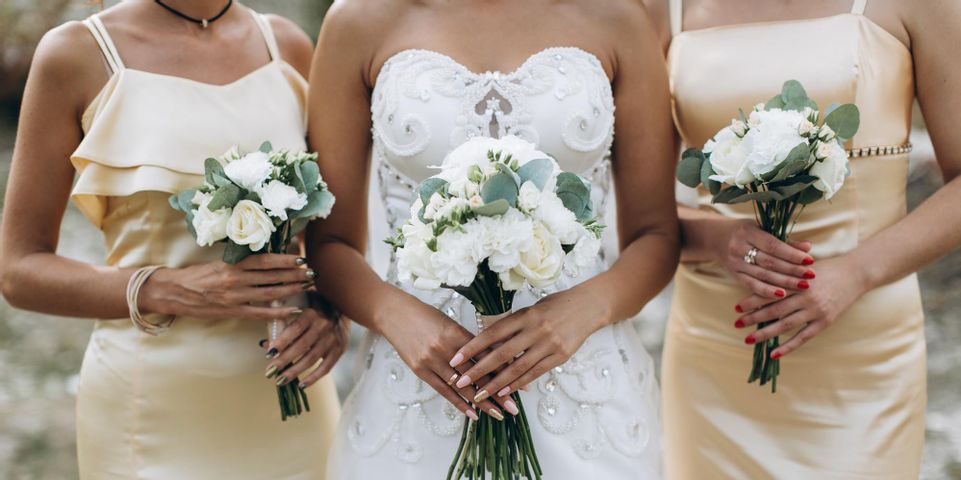
When you have dreamt of your wedding your whole life, you want every detail to align with your vision. Sometimes, though, what's out there on the market can't quite meet your expectations. If you're talented enough to call yourself a sewist, take matters into your own hands for your bridal party by making their dresses for the big day. Whether you're envisioning a spandex blend stretch velvet gown or a soft and sweet lace number, here's everything you need to consider having your bridesmaids in custom looks for your wedding.
Design Considerations
Silhouette
 The most challenging choice with bridesmaid’s dresses is deciding on a shape that flatters the body types of all your bridesmaids. Wedding trends have shifted to accommodate different body types through the use of different style dresses in the same fabric. If you think you are capable of creating different styles for each of your bridesmaids, this option is a great choice when you're making them yourself.
The most challenging choice with bridesmaid’s dresses is deciding on a shape that flatters the body types of all your bridesmaids. Wedding trends have shifted to accommodate different body types through the use of different style dresses in the same fabric. If you think you are capable of creating different styles for each of your bridesmaids, this option is a great choice when you're making them yourself.
If you have to create more than a few dresses, though, opting for one dress pattern may streamline the process a little bit. A-line dresses tend to be the most universally flattering, as they typically imitate an hourglass figure for those with fewer curves and accentuate more full figures. Steer clear of strapless dresses for the sake of bridesmaids will fuller busts, and consider flowy material for skirts and stretchy ones, like spandex blends, for the bodice.
Room for Alterations
When designing these custom dresses, whether or not you incorporate room for alterations depends entirely on if your bridesmaids can come for regular fittings during the process. The primary benefit of this project is the custom tailoring you have to offer, but if you have a bridesmaid giving you measurements remotely, it may be helpful to construct the garment with let out room. Then, when they come into town for a bridal shower, bachelorette party, or the like, you can do the custom tailoring on the garment and trim the seams when you're positive that the dress will fit her perfectly.
Timing
If you have a large bridal party, don't expect this sewing project to come together in a matter of a month. Even if you're only sewing one or two dresses, give yourself ample time to prepare them for your wedding, at least six months in advance. That way, you can ensure that the only thing keeping you up the night before your big day is wedding day jitters, not last-minute alterations.
Fabric Choices
Stretch Velvet
A spandex-blended velvet is a chic and comfortable option for your bridesmaids. The stretch of the fabric can accentuate curves and give wiggle room for those reception dance floor jams, but the buttery sheen of the material will keep it a formal affair. As a bonus, deep jewel tones tend to complement a variety of complexions, avoiding a common point of contention amongst many a bridal party.
Decorative Stretch Lace
Similar to stretch velvet, the spandex component of stretch lace combines function with formality. Best used as an overlay on the bodice or the makings of a sheer sleeve, stretch lace or mesh can provide a flirty and feminine touch to a bridesmaid’s dress. While suitable for any theme, this material aligns particularly well with a garden party-style wedding given the oft floral pattern of many lace options.
Stretch Sequin
For a bridal party with a little attitude, a sequin or beaded material can be a fun fabric to work with for their dresses. Bridesmaid’s dresses typically use tiny sequined fabrics when they want a little sparkle, ornamenting an otherwise comfortable spandex material. Combined with your wedding colors, you can create a stunning dress that your bridesmaids will want to wear to every black-tie following your big day.
Chiffon
For the skirt, in particular, chiffon is almost always a winner at weddings. The material is lightweight and incredibly flattering, offering a flowy aesthetic without too much volume. When paired with an A-line waist, it lengthens and slims—just make sure you leave the hemline a little bit longer to do this fabric justice.
Tips for Clean Finishes
Check the Grain
 With handmade garments, even the most straightforward pattern will look off if you don't pay attention to every detail. Before you cut, confirm the direction of the grain so that the garment wears well and doesn't tug at the wrong places. For spandex blends, in particular, the grain is essential to its stretch. Make sure you get this right before cutting, or you'll waste loads of time and material only to start over again.
With handmade garments, even the most straightforward pattern will look off if you don't pay attention to every detail. Before you cut, confirm the direction of the grain so that the garment wears well and doesn't tug at the wrong places. For spandex blends, in particular, the grain is essential to its stretch. Make sure you get this right before cutting, or you'll waste loads of time and material only to start over again.
Take Your Time Cutting the Pattern
When you cut out the pattern, use sharp sewing shears or a rotary cutter to guarantee a clean line with every cut. Clean lines are essential to the look of the final product, as every misshapen seam is a visible sign of a homemade look. When in doubt, make every measurement twice to confirm the dimensions of the garment.
Tend to Your Seams
For professional-looking seam allowances, aim for 1 to 1.5 centimeters of seam fabric. Your sewing machine may have markers on the footplate to measure this dimension, but you can follow up with measuring tape if you're unsure. Pressing seams is also a valuable step, though it takes more time, but it can make all the difference as you sew the garment together.
Even if you don't have a serger, finish any raw edges with a zigzag stitch, which you can reinforce with a straight stitch to imitate an overlock stitch. This step avoids any loose threads that will unspool and disintegrate the garment as it's worn. Finishing edges also make the whole look a lot cleaner, as they are usually standard on store-bought clothing.
Color Match Thread
Often, the desperation of running out of thread can throw a wrench in color-matching. Think twice before you reach for that similarly colored thread in your sewing kit; that subtle difference will be glaringly evident in the final product. If you can run to the store right away, press pause on the project until you can, and once you stop at the store, stock up on plenty of that thread, so you don't have a repeat situation.
Pay Attention to Final Details
As with any product, the home stretch is the most crucial point of contention for a project's overall success. Even if you double-checked your measurements and pressed every seamline, analyze the final product to ensure it is up to the standard that you expect for your wedding day.
While you tailor the dress, keep a firm eye on the leveling of the hemline. A sloped hemline—even on a floor-length dress—are an apparent amateur mistake that you can avoid with a little attention to detail. Double-check that the sleeves are the same length as well, and tailor accordingly. If you're not happy with how the waist rests, take it up an inch. Since you afforded yourself the opportunity for custom tailoring, take advantage of it. The odds are that these minute details will make you confident in your craftsmanship, and your bridesmaid will feel comfortable and fabulous in the final garment.
When designing bridesmaid’s dresses, using a stretch fabric can be a resourceful way to ensure your bridal party looks and feels fantastic on your wedding day. To help you get a start on these garments, Spandex House has a vast selection of spandex fabrics to suit any design taste. From stretch sequins to velvet, lace, and more, you can bring to life a stunning gown in time for your big day. For more information about this Manhattan, NY, fabric supplier and to order samples, visit our website or give us a call today at (212) 354-6711.
About the Business
Have a question? Ask the experts!
Send your question

